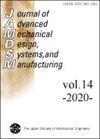Autonomous optimization of cutting conditions in end milling operation based on deep reinforcement learning (Offline training in simulation environment for feed rate optimization)
IF 1
4区 工程技术
Q4 ENGINEERING, MANUFACTURING
Journal of Advanced Mechanical Design Systems and Manufacturing
Pub Date : 2023-01-01
DOI:10.1299/jamdsm.2023jamdsm0064
引用次数: 0
Abstract
Full automation of manufacturing is strongly desired to improve the productivity. Autonomous optimization of the cutting conditions in the end milling operation is one of the challenges in achieving this goal. This paper proposes a system for optimization of the cutting conditions based on Deep Q-Network (DQN), which is a kind of deep reinforcement learning. An end mill is used as an agent and the end milling simulation is employed to provide the environment in the proposed system. Geometric information of interference state between tool and workpiece in the simulation is considered as the state of the environment and acceleration of feed rate is the action for the agent to take. The action is optimized by DQN to maximize the accumulated reward given from the environment, which evaluates how good the scenario of action is. Therefore, the cutting conditions can be optimized according to the defined reward function. We performed three case studies to verify our proposed method, in which the cutting torque is controlled to be a specified value. The objective was successfully achieved regardless of differences in the end milling scenario. The obtained results strongly suggested a fact that the reinforcement learning is a promising solution to autonomous optimization of the cutting conditions.基于深度强化学习的立铣削切削条件自主优化(进给速度优化仿真环境下的离线训练)
为了提高生产效率,人们强烈希望实现制造业的全自动化。在立铣削过程中自主优化切削条件是实现这一目标的挑战之一。本文提出了一种基于深度强化学习的深度q网络(Deep Q-Network, DQN)的切削条件优化系统。以立铣刀为代理,利用立铣刀仿真提供系统运行环境。仿真中刀具与工件干涉状态的几何信息作为环境状态,进给速度的加速是agent所采取的动作。DQN对行动进行优化,以最大化环境给予的累积奖励,这评估了行动场景的好坏。因此,可以根据定义的奖励函数对切削条件进行优化。我们进行了三个案例研究来验证我们提出的方法,其中切割扭矩被控制为一个规定值。无论端铣方案的差异如何,目标都成功实现了。得到的结果强烈地表明,强化学习是一个有前途的解决方案,自主优化的切削条件。
本文章由计算机程序翻译,如有差异,请以英文原文为准。
求助全文
约1分钟内获得全文
求助全文
来源期刊
CiteScore
2.00
自引率
0.00%
发文量
25
审稿时长
4.6 months
期刊介绍:
The Journal of Advanced Mechanical Design, Systems, and Manufacturing (referred to below as "JAMDSM") is an electronic journal edited and managed jointly by the JSME five divisions (Machine Design & Tribology Division, Design & Systems Division, Manufacturing and Machine Tools Division, Manufacturing Systems Division, and Information, Intelligence and Precision Division) , and issued by the JSME for the global dissemination of academic and technological information on mechanical engineering and industries.

 求助内容:
求助内容: 应助结果提醒方式:
应助结果提醒方式:


